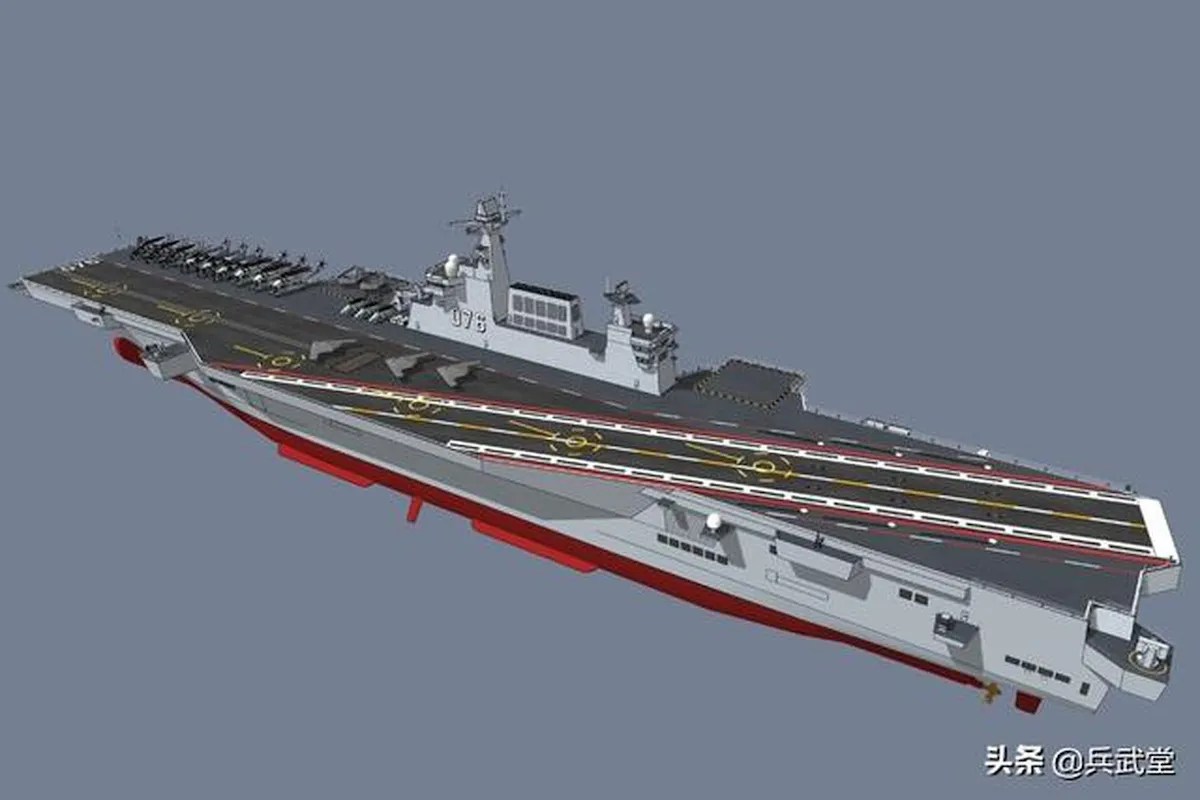On August 1, the Center for Strategic and International Studies (CSIS), a US think tank, released a report revealing the rapid advancement in the construction of China’s Type 076, a Yulan-class landing helicopter assault (LHA) ship.
The report, based on satellite data from July 4, 2024, said that the Type 076 was on track to be launched in the first half of 2025.
Following its launch, it will require several months, or even years, before it is fully commissioned into the People’s Liberation Army Navy (PLAN).
The vessel is poised to become the largest amphibious assault ship in the world. Its flight deck measures approximately 260 meters by 52 meters—equivalent to nearly 13,500 square meters, or the size of three American football fields.
The Type 076’s impressive dimensions surpass those of the US Navy’s America-class LHAs and the Japanese Izumo-class helicopter carriers. It is also significantly larger than its Chinese predecessor, the Type 075.
NEW: We've just released satellite imagery showing the latest progress on construction of China's massive new Type 076 warship, which is shaping up to be something between an aircraft carrier and an amphibious assault ship. https://t.co/kYKVHsfX0r pic.twitter.com/0BSDUef9Vp
— Brian Hart (@BrianTHart) August 1, 2024
The new ship represents a major enhancement in the PLA’s ability to project power beyond China’s coastline, marking a notable leap in its naval capabilities.
The CSIS report noted that Type 076’s construction speed was remarkable, even by “the standards of China’s prolific shipyards.”
The report compared the construction timelines of China’s Fujian aircraft carrier and previous Type 075 ships and suggested that Type 076’s rapid development reflects China’s growing expertise in large-scale naval construction.
A particularly noteworthy aspect of Type 076’s construction is its assembly at a newly completed dry dock on Changxing Island, which was finished in September 2023.
This dry dock is currently also hosting the construction of three Type 054A guided-missile frigates, highlighting the extensive shipbuilding capabilities being developed at the site.
The report added that while the introduction of the Type 076 was not expected to fundamentally alter the military balance in the Indo-Pacific region, it would enhance the PLA’s capacity to project combat power across the Western Pacific, South China Sea, and beyond.
The development of such advanced naval assets reflects China’s ongoing commitment to strengthening its maritime forces and extending its strategic reach.
How Capable Is China’s Massive Next-Generation Amphibious Assault Ship?
China’s numerous territorial and maritime disputes with other countries in the Indo-Pacific region make amphibious platforms crucial for deploying and sustaining troops at a distance.
Such platforms are essential in a region with many island nations. Therefore, this monstrous vessel will significantly enhance Beijing’s ability to assert its dominance in the area.
In addition to its impressive size, the Type 076 introduces several advanced technological features that distinguish it from other amphibious assault ships. Most notably, it will include a catapult system designed for launching fixed-wing aircraft.
This capability is unprecedented for amphibious assault ships, which have traditionally been limited to launching helicopters and V/STOL aircraft like the F-35B. China has not yet deployed manned aircraft with V/STOL capabilities.
The report mentioned that the catapult system on the Type 076 was expected to be similar to the electromagnetic aircraft launch system (EMALS) used by US Ford-class aircraft carriers.
This cutting-edge technology provides greater power than traditional steam catapults, enabling the launch of larger and heavier aircraft.
China’s confidence in this technology is evident in its use of EMALS on its Type 003 Fujian aircraft carrier, which is equipped with three EMALS-style catapults.
The Type 076 features a catapult trench that is nearly 130 meters long, surpassing the 108-meter catapults on the Fujian carrier. However, CSIS clarified that more data was needed to confirm the exact specifications and capabilities of Type 076’s catapult system.
Satellite imagery also revealed that Type 076 will have aircraft elevators on both sides of the ship, facilitating efficient movement of aircraft from the internal hangar to the flight deck.

The design is an improvement over the Type 075’s configuration, which includes a larger aft elevator and a smaller forward elevator that can obstruct the flight deck when in use.
These features enable the Type 076 to potentially launch fixed-wing aircraft, which generally offer greater range, speed, and payload capacity compared to helicopters. At the very least, the ship will be capable of launching fixed-wing UAVs (Unmanned Aerial Vehicles) and UCAVs (Unmanned Combat Aerial Vehicles), which are easier to launch and recover than manned aircraft.
Should the Type 076 concentrate solely on unmanned systems, it will still feature a highly capable air wing. China’s expanding UAV inventory includes the GJ-11 stealth combat drone, the WZ-7 reconnaissance drone, and the CASC Rainbow strike UCAV.
In June, EurAsian Times reported that satellite images of the Changxing Island Shipbuilding Base revealed what seem to be GJ-11 drone mock-ups in a testing facility, likely preparing for trials on the Type 076 once finished.
The inclusion of a catapult system, a wider flight deck, and unobstructed runway space suggests that Type 076 could potentially launch manned aircraft, positioning it uniquely between an LHA-class ship and a full aircraft carrier. However, this would require the PLA to address several new technical and operational challenges.
Further, enhancing its naval aviation capabilities through the introduction of Type 076 vessels would provide the PLAN with significantly greater operational flexibility near the mainland.
The advanced amphibious assault ship could play a crucial role in various military strategies, including potential interventions against Taiwan and defending its extensive and contested territorial claims.
- Contact the author at ashishmichel(at)gmail.com
- Follow EurAsian Times on Google News




